Unified Field Power Converter - by Jose Zoleta
KeelyNet 12/19/01Field of Invention This invention relates to the unique 'Addmotech' concept using (2) anti-parallel independently connected stationary armature windings and more particularly the new use of Dynamic Braking or motor action in a generator for propulsion. Background of the Invention In the temple at Gordium were a cart and yoke dedicated to the god Zeus. The knot of the yoke was called the GORDIAN KNOT and was so cleverly tied that it was said the man who could undo it, would be emperor of the world. There was a legend that Alexander drew his sword and cut the knot instead of trying to untie it in the year 333BC. In the same parallelism, it was in 1972 when the OPEC countries set to prove that power comes not only from the barrel of the gun, but also from the barrel of oil. This triggered the search for alternative sources of energy. The symbolical GORDIAN KNOT (which is Lenz's Law) tied to a barrel of oil came into existence without their knowledge and consent. Whoever can untie the symbolical GORDIAN KNOT (Lenz's Law) will solve the Energy Crisis without dependence on a barrel of oil. This has to be untied by the intellectual sword of knowledge. Thus, the untying or cutting the symbolical GORDIAN KNOT (Lenz's law) became the primary object of this disclosure. To date, mankind had at least four (4) important discoveries;
Now comes the 'Addmotech' concepts that will be used to untie or cut the symbolical GORDIAN KNOT (Lenz's law). One cannot cut diamonds without using other diamonds. By the same token, Lenz's Law can also be utilized in a Free Energy Device. We are living in a world of dual and proper pairs of contra's or opposites, i.e., hot/cold, negative/positive, dynamic braking torque/anti-dynamic braking torque, motor action/generator action, matter/anti-matter, etc.. The existence of anti-matter, first predicted by Paul Dirac in 1929 was later conclusively demonstrated by the discovery of the anti-electron (or positron) by Carl Anderson at CalTech in California. For their pioneering work, both Paul Dirac and Carl Anderson were awarded Nobel Prizes in 1929 and 1935, respectively. In Biochemistry, a theoretical model of DNA structure, proposed by J.D. Watson and F.H. Crick (1958) accounts for the four essential properties of genes - specificity, replication, mutation and function. According to this model, the genetic material in a virus particle is constituted in (2) two closely paired anti-parallel helical chains coiled around a common axis now known as the DNA Double Helix. These parallel chains are complementary in that for each base in one chain there is a corresponding but different base in the other chain which pairs with it, Adenine always pairing with Thymine and Cytosine with Guanine. The 'Addmotech' concept utilizes the DNA double helix 'six building block' and could be compared to the 'Rosetta Stone' that provided a key for deciphering the Free Energy Code. (A)denine can only combine with (T)hymine
- fire,
- the wheel,
- gunpowder
- and atomic energy.
1. Motor mode main winding (11) can only combine or pair with Generator mode Reverse Complimentary Winding (12).(G)uanine can only combine with (C)tyosine
2. Generator mode Main Winding (11) can only combine or pair with Motor mode Reverse Complimentary Winding (12).The Law of Electrical Charges The Law of Electrical Charges is that particles with like charge repel each other, and those with unlike charge attract each other. Normally, an atom contains the same number of electrons and protons, so that the equal and opposite charges cancel each other to make the atom electrically neutral. If an atom contains less electrons than protons, it will have a positive charge. If it has more electrons than protons, it will have a negative charge. Charged atoms are called ions. Electricity is produced by separating electrical charges. Charge flows when there is a potential difference ascorss the ends of a conductor. This charge persists until both bodies reach a common potential. It can be done in a variety of ways, all of which fall into six accepted categories.1. Friction - TriboelectricityOf the (6) six mentioned above only chemical batteries or generators are capable of maintaining a steady flow. Any seat of EMF such as a battery or generator is a source of energy. In chemical batteries, the disintegration of zinc or lead in acid results in a separation of electric charge, and the energy stored in the chemical bonds is converted into electrical energy. Both batteries and generators separate charges and move them to opposing terminals and constitutes the difference in potential (voltage) that provides the 'electrical pressure' that will move electrons through a circuit joined to the terminals. Electric current is simply the flow of electrical charge. In solid conductors, it is the electrons that flow through the circuit; while in fluids, ions as well as electrons may compose the flow of electric charge. It is very unfortunate that these conventional generators or alternators require a secondary source of energy for operational purposes. In other words, they cannot operate by themselves due to technological, (i.e. geometrical, physical or design) constraints. Dynamic Braking Consider a shunt motor whose field is a permanent magnet rotor and whose stationary armature is connected to a source by means of a switch. Taking note of the direction of the armature current I1 and the polarity of the cemf Eo. If we suddenly open the switch the motor continues to turn, but its speed will gradually drop owing to friction and windage losses. On the other hand because the shunt field is still excited being a permanent magnet, induced voltage Eo continues to exist, falling at the same rate as the speed. In essence the motor is now a generator whose armature is an open circuit. Let us close the switch so that the armature is suddenly connected to an external resistor (load). Voltage Eo will immediately produce an armature current I2. However, this current flows in the opposite direction to the original current I1. It follows that a reverse torque is developed, whose magnitude depends upon I2. The reverse torque brings the machine to a rapid, but very smooth stop. This Dynamic Braking function is being used more than a hundred million times every day here and abroad in elevators and subway cars of the Transit system as a source of energy in the negative way. This Dynamic Braking function is actually the motor action in a generator. This tremendous waste of energy could be well used to provide propulsion of almost anything (i.e. automobile, train, ship, airplane, etc..).
2. Chemicals - Electrochemistry
3. Pressure - Piezoelectricity
4. Heat - Thermoelectricity
5. Light - Photoelectricity
6. Magnetism - MagnetoelectricityLegend 
In essence, both DDT and DBT are motor action in a generator or alternator for a given rotation of the prime mover. In other words, DDT will change to DBT and DBT to DDT if the original parameters are changed. The foregoing and other objects and features of the invention relating to such measures utilizing Dynamic Braking Torque or motor action in a generator or alternator for propulsion will be evident from the following detailed description of the preferred embodiments thereof and practices thereunder, and drawings wherein like reference numerals indicate like parts throughout.
DBT
acronym for Dynamic Braking Torque
synonym for motor action in a generator
antonym for Dynamic Driving TorqueDDT
acronym for Dynamic Driving Torque
metonym for Anti-Dynamic Braking Torque
synonym for Paradoxical motor action in a generatorMM
Motor mode
GM
Generator/Alternator mode
11
Main reference circuit winding
12
Anti-parallel complimentary circuit winding
CW
Clockwise rotation
CCW
Counterclockwise rotation
Drawing Figures Five (5) primitive schematic diagrams will be presented to fully comprehend the Unified Field Power Converter. Referring to Fig. 1 we have (2) two anti-parallel armature stationary windings wound in a common core 15, an infinite solenoid which actually is a toroid. Armature winding 11 consists of terminals 1, 3, 5 & 7. Armature winding 12 consists of terminals 2, 4, 6, 8. Mode selector Sm SCR/CB 13 load 9 and 10. 
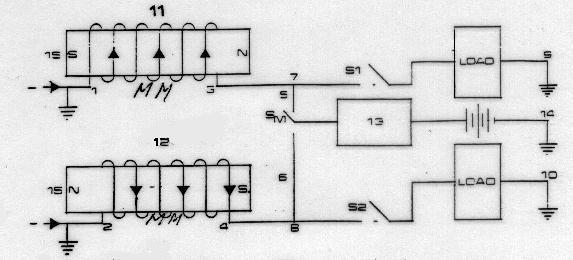
Referring to Fig. 2 is the same as Fig. 1 except only armature winding 11 is used, first run in motor mode with terminal 3 connected to terminal 7. At rated speed mode selector switch Sm is disconnected, the motor armature winding 11 is now a generator in open circuit. Terminal 1 is now connected to terminal 7 and terminal 3 to the ground. We now connect load 9 by closing S1. This is dynamic breaking mode of armature winding 11. 
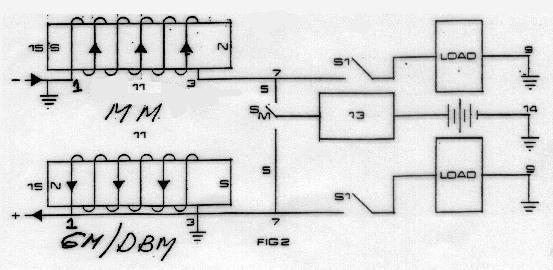
Referring to Fig. 3 is the same function as in Fig. 2 where armature winding 12 is first run in motor mode at rated speed. Then opening mode selector switch Sm. Armature winding 12 is now a generator in open circuit condition. We connect terminal 4 to ground and terminal 2 to terminal 8. Closing S2 to load 10 we now have dynamic braking function of armature winding 12. 
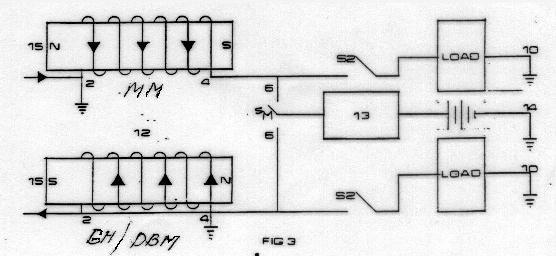
Referring to Fig. 4 we start with winding 12 as motor mode same as in Fig. 1. Armature 11 is so connected in generator mode as in Fig. 2. Since the polarity of core 15 is the same while armature winding 12 is in motor mode and armature 11 in generator mode. This is therefore, the correct pairing or mating similar to the DNA double helix, where (A)denine always pairs with (T)hymine and (C)tyosine with (G)uanine. 
We could now shut-off motor mode armature 12 and connect S1 to load 9. The load current will serve as the input current to run armature winding 11. 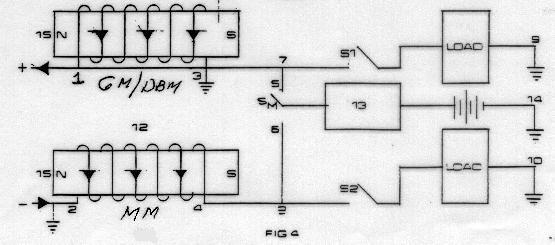
Referring to Fig. 5, this is the same function as shown in Fig. 4. Armature winding 12 is so connected in generator mode as in Fig. 3. Since the polarity of core 15 is the same while armature winding 11 is in motor mode and armature winding 12 in generator mode, or dynamic braking mode. This means that the direction of their currents and torque are the same. Again this is the correct pairing or mating. We could shut off motor mode armature winding 11 and connect S2 to load 10. The load current will serve as the input current to run armature winding 12. 
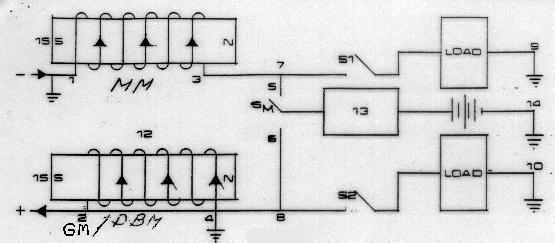
Conclusion In summation, dynamic braking mode or motor action in a generator can be utilized as a new source of energy for propulsion using the principle of the DNA double helix or anti-parallel windings where proper pairing and mating are possible. In other words, the output load current in one winding and the input current in the anti-parallel winding and vice-versa, have the same direction for a given rotation of the power converter because of proper pairing and mating. Acknowledgements Many people, relatives and friends have contributed ideas, time and money to this project over the past 47 years since I finished my baccalaureate degree in Electrical Engineering, and too many to be listed here. Mrs. Rosario Macam Zoleta whose daughter Marie Josephine prepared and typed this article, and also Mrs. Rosario Zoleta Revilla whose son Ryan prepared the drawings. References Since accepted laws of physics and Electrical Engineering are also too many to list here, I will cite just a few;  1. Electricity ONE-SEVEN by Harry Mileaf, Editor in Chief, Hayden Book Co. Inc., New York; Edition 1966 2. Nikola Tesla's Later Generator Design by Oliver Nichelson at the 26th IECEC Boston, Mass., August 4-9, 1991 3. Electrical Machines, Drives and Power Systems by Theodore Wildi, Prentice Hall, Second Edition, 1991 4. TAF - 13 An Alternative Source of Energy by Jose C. Zoleta at 26th IECEC Boston, Mass., August 4-9, 1991 5. Philippine Patent #27201 May 23, 1993; Title UNIFIED POWER CONVERTER, Inventor - Jose C. Zoleta
1. Electricity ONE-SEVEN by Harry Mileaf, Editor in Chief, Hayden Book Co. Inc., New York; Edition 1966 2. Nikola Tesla's Later Generator Design by Oliver Nichelson at the 26th IECEC Boston, Mass., August 4-9, 1991 3. Electrical Machines, Drives and Power Systems by Theodore Wildi, Prentice Hall, Second Edition, 1991 4. TAF - 13 An Alternative Source of Energy by Jose C. Zoleta at 26th IECEC Boston, Mass., August 4-9, 1991 5. Philippine Patent #27201 May 23, 1993; Title UNIFIED POWER CONVERTER, Inventor - Jose C. Zoleta
If you found this file useful or interesting, please consider a donation or a purchase to help keep KeelyNet online and providing free information. Even a dollar will help. Others sell it, we prefer to share it, thanks! |